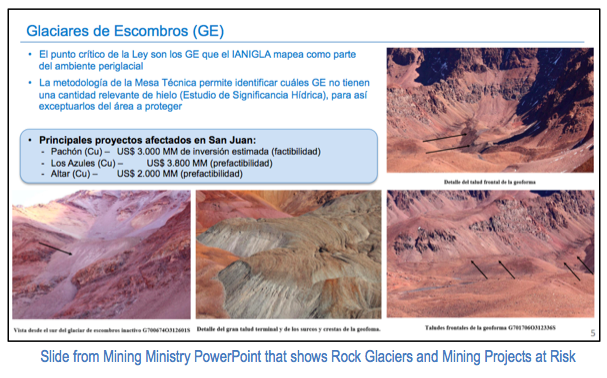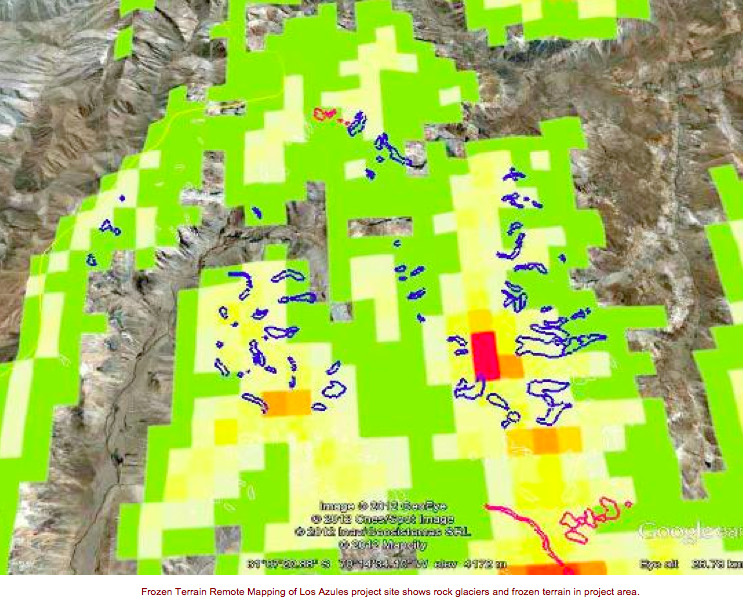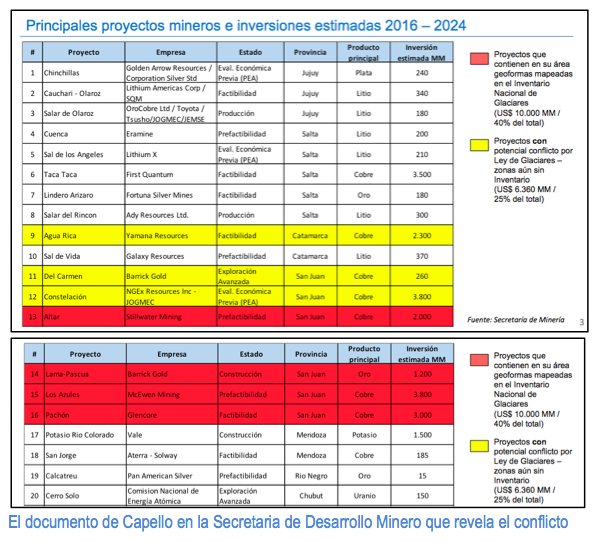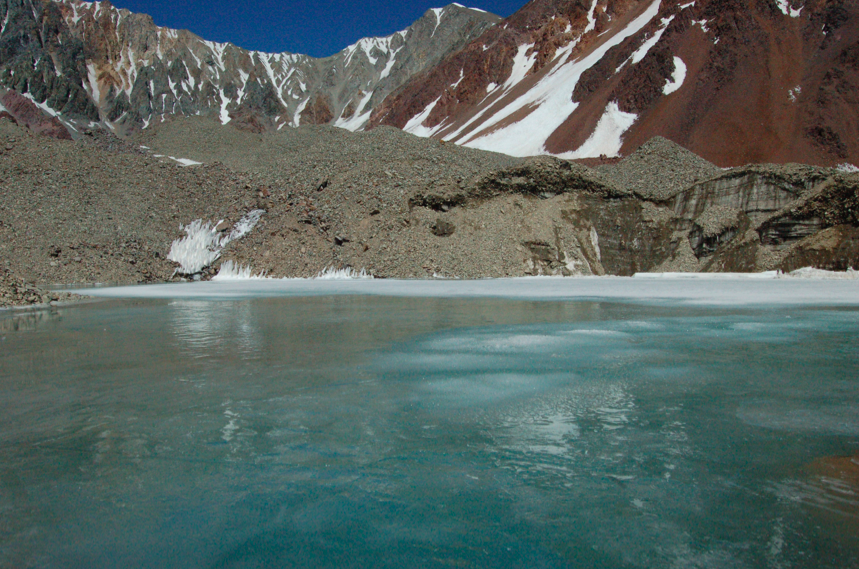Esta entrada también está disponible en: Spanish
[Debris Covered Glacier in the Central Andes, a significant water source at risk due to incoming mining investments. Photo: JP Milana]
December 27, 2016 – San Juan Argentina.
In the midst of a crackdown by the Argentine Federal Justice System of public officials that have skirted responsibilities on compliance with Argentina’s glacier law, confidential documents of Argentina’s Federal Mining Ministry were leaked to the media revealing that the Ministry admits that at least seven large-scale mining projects in the Central Andes of Argentina are in conflict, or could potentially be in conflict with the recently passed National Glacier Protection act, which prohibits mining in glacier and periglacial areas. It’s the first time the Argentine government has recognized problems between its glacier law and mining projects.
The projects were listed in a Powerpoint presentation delivered recently in a private meeting between the Mining Ministry and the Ministry of Environment. On one of the slides of the presentation, El Pachón (Glencore), Los Azules (McEwen), Altar (Stillwater), and Pascua Lama (Barrick Gold), are listed as “projects which contain geological forms [understood to be glaciers or rock glaciers] that are listed by the National Glacier Inventory”–meaning essentially that they would be in legal conflict with the law. Meanwhile, Agua Rica (Yamana), Constelación (NGEx Resources), and Del Carmen (Barrick Gold) are each listed as “projects that are potentially in conflict with the National Glacier Law in areas that are not yet covered by the National Glacier Inventory which is presently underway–they could be illegal if when completed, the Glacier Inventory shows them to be in glacier areas.
This revelation was quickly picked up by a federal judge, who is presently overseeing a portion of Barrick Gold’s Veladero contamination case, and who is carrying out an investigation to determine if public officials have skirted responsibility on the implementation of Argentina’s glacier law as well as on other environmental counts having to do with mining sector due diligence.
Organizations like the Center for Human Rights and Environment (CHRE) have been saying for years that many of Argentina’s wish list mining projects like El Pachón, Los Azules, Pascua Lama and others, are in direct conflict with the Glacier Law and should not move forward. While both the federal government and the provincial governments of provinces like San Juan, where many of these projects are located have denied any conflicts between the Glacier Protection Law and the envisioned mining projects, these leaked documents tell a different story, indicating that government officials have known all along that mining is indeed impacting glaciers, and that many of these projects are environmentally, and legally, simply not viable.
It is unknown who leaked the documents, but they were obtained by the Jachal Assembly, a group of local residents of mining country in San Juan, that has long expressed concern over mining impacts in the vicinity of Pascua Lama and Veladero. Ironically the leaked documents were authored by the Undersecretary of Mining Development, Mario Capello and his team. Capello is a staunchly pro-mining advocate, and has publicly declared himself against the mining prohibitions outlined in the glacier law. He has also systematically denied that periglacial areas (permafrost areas) have any hydrological value whatsoever. In the leaked powerpoint (see image below), the Mining Ministry does not stress any hydrological significance of these glacier resources, but does point out that US$8.8 billion could be in jeopardy if the glacier law stands.

The other document leaked to the press is a draft regulatory ordinance which the Mining Ministry hopes will replace existing regulations for implementing the glacier law. The powerpoint is clear about the intent of this ordinance, which is to water down the law, limit the applicability of the law only to those glacier resources deemed to be hydrologically relevant, and flex the restrictions on mining to allow projects to go forward.
The powerpoint says bluntly, “The methodology of the Technical Group permits the identification of which RGs [Rock Glaciers] do not contain a relevant amount of ice (Hydrological Significance Test), so as to be able to exclude them from the protected areas.”
The statement is in clear violation of the National Glacier Law, since all glaciers and periglacial areas, regardless of size or hydrological significance, are protected by law. It also shows how the Mining Ministry is attempting to manipulate the application of the law to be more flexible with mining operations that are likely to destroy glaciers or permafrost areas.
Whatever the intent of the documents, civil society groups are vehemiently denouncing the Mining Ministry as well as the Environment Ministry which allegedly collaborated with Capello’s team in the development of the leaked documents. The Federal Judge of the Barrick case has stepped in to the affair ordering searches in both Ministries and calling on public officials to uncover what is behind this effort by both ministries to put forth this lax regulatory ordinance for the glacier law.
What is clear to us, says Jorge Daniel Taillant*, Director of the Center for Human Rights and Environment is that the government has known all along about the conflicts between certain mining operations and glaciers and periglacial areas. These documents prove that there are serious conflicts. We’ve produced numerous reports detailing this impact both from exploratory mining work as well as potential impacts if some of these projects were to move forward.”
Romina Picolotti, the former federal Environment Secretary, resigned from her post when former President Cristina Fernandez vetoed the first version of the Glacier Law in 2008–a law that had been passed unanimously by Congress. The President vetoed the law, in her own words, to protect mining interests, of projects such as El Pachon (Glencore) and Pascua Lama (Barrick Gold) which were gearing up to launch. Legal problems (related to glaciers impacts), financing problems (related to export credit loans that fell apart after environmental complaints filed against Barrick), macro-economic difficulties related to Argentina’s unstable economy and restrictive cashflow policies, as well as falling global mineral prices all contributed to indefinitely stalling these projects from launch back in 2012-2014. Today Barrick Gold is said to be dismantling Pascua Lama, and allegedly proposing to split it up into two projects. Other rumors include that Barrick is now attempting to sell it off its complicated assets in the Central Andes to Chinese investors. Glencore, despite claims in Argentina that El Pachón is to move forward, has recently indicated that it is not sure if El Pachón will be moving forward anytime soon.
All of the projects listed by the Ministry as potentially in conflict with Argentina’s Glacier Protection Law have been documented. Studies are underway or have been carried out that show past, present and potential future impacts to glaciers and/or to periglacial areas (active permafrost) if mining were to occur in the area. This would make these projects illegal under Argentina’s new Glacier Law, in force since 2010.

In Catamarca Province, the Agua Rica (Yamana Gold) and the Filo Colorado project (explored by Xstrata Copper, now Glencore) have extensive visible mining roads cutting through periglacial areas, including active rock glaciers. The companies have denied any impacts as has the provincial government.
Los Azules by McEwen Mining is another project awaiting advancement under more favorable conditions. This is one of the projects on the government’s red list, that is, the leaked list of currently problematic projects. The satellite map image below showing frozen terrain in the project concession area shows why. Los Azules is surrounded by periglacial environment protected by law.

The El Pachón project in San Juan Province also shows extensive conflict between periglacial environments, rock glaciers and mining operations. Exploratory work has already greatly altered the terrain, but project advancement would generate extensive impacts and destroy several rock glaciers in the project area. In the case of El Pachón, before there was ever any indication that there would be a glacier law passed, the company had already published a routine permafrost inventory and mapping of rock glaciers in the project area, with some 200 cryogenic forms identified.

Below is the excel table which was leaked and circulated widely showing the Mining Ministry’s recognition that a number of projects are indeed in conflict areas with respect to Argentina’s glacier law.

Capello’s job was to fix the glacier problem for the mining companies, but it seems his work did quite the opposite, revealing the problem, not resolving it. The mining ministry’s leaked documents are now dousing gasoline onto an already fiercely burning fire pushed by the environmental community against mining companies wishing to promote projects in the High Andes, with the argument that they will impact glaciers, and surely to his chagrin, the Mining Under Secretary Mario Capello is proving them right.
For more information:
Jorge Daniel Taillant*
[email protected]
+14157132309
RELEVANT LINKS:
Powerpoint by the Mining Ministry Leaked to the Public (in Spanish)
https://center-hre.org/wp-content/uploads/Powerpoint-Mineria-Glaciares.ppt
Proposed Regulatory Decree Leaked to the Public (Spanish)
https://center-hre.org/wp-content/uploads/Re-reglamentacion-LEY-DE-GLACIARES.pdf
Report on Rock Glacier Impacts at El Pachón
https://center-hre.org/wp-content/uploads/2011/08/Glaciar-Impact-Report-el-pachon-xstrata-FINAL-english-version-may-23-2011.pdf
International Complaint Filed Against Xtrata Copper for Rock Glacier Impacts
https://center-hre.org/wp-content/uploads/2011/06/Specific-Instance-xstrata-copper-glaciers-June-1-2011-final-english.pdf
Report on Rock Glacier Impacts at Los Azules (McEwen Mining)
https://center-hre.org/wp-content/uploads/2012/07/Glaciar-Impact-Report-Los-Azules.pdf
International Complaint Against McEwen Mining in Canada for Rock Glacier Impacts
https://center-hre.org/wp-content/uploads/2012/07/Request-for-Review-McEwen-CEDHA.pdf
Report on Rock Glacier Impacts at Agua Rica and Filo Colorad0 (Spanish Only)
https://center-hre.org/wp-content/uploads/2011/09/Informe-Glaciares-de-Aconquija-Impactos-de-Mineria-Agua-Rica-y-Xstrata-Final-feb-18-2011.pdf
Report on Mining and the Periglacial Environment in Argentina
https://center-hre.org/wp-content/uploads/2012/11/El-Ambiente-Periglacial-y-la-Mineria-en-la-Argentina-English.pdf
Report on Barrick’s Glaciers
https://center-hre.org/wp-content/uploads/2013/05/Los-Glaciares-de-Barrick-Gold-version-20-mayo-2013-ENGLISH-small.pdf
* Jorge Daniel Taillant directs the Center for Human Rights and Environment (CHRE/CEDHA), which he founded with Romina Picolotti, Argentina’s Environment Secretary from 2006-2008. Picolotti worked on drafting Argentina’s first glacier protection law, passed in 2008, but vetoed by President Cristina Fernandez, admittedly to favor mining interests. Considering the political context, and his assumption that neither the new Argentine Environment Minister, nor the mining authorities would work effectively to implement the glacier law, or to carry out the glacier inventory called by the law, Taillant sought training on glaciology, and specifically on techniques to map glaciers and rock glaciers. With the help of renowned glaciologists, he carried out his own inventory including more than 5,000 glaciers and rock glaciers in mining areas and authored a number of reports showing mining impacts to glaciers, rock glaciers, and more generally to periglacial areas.

